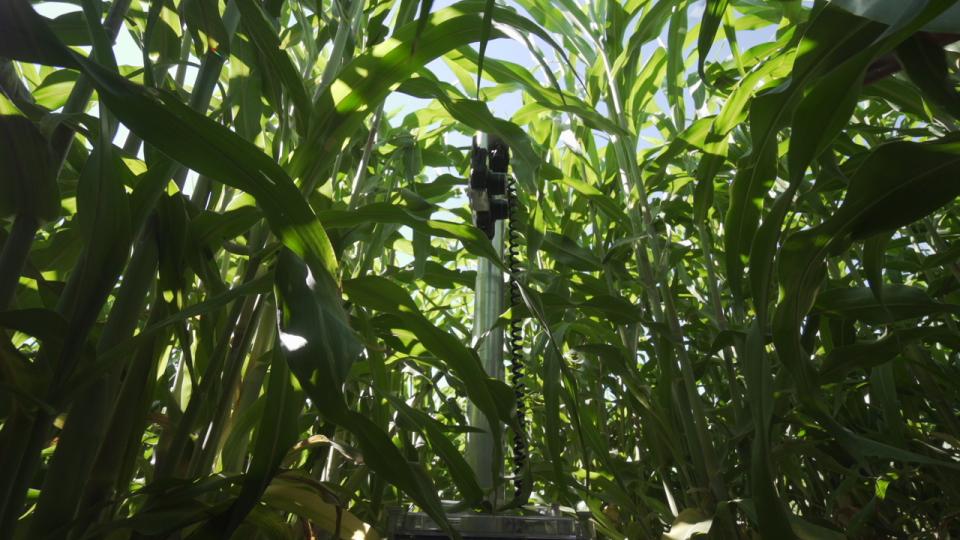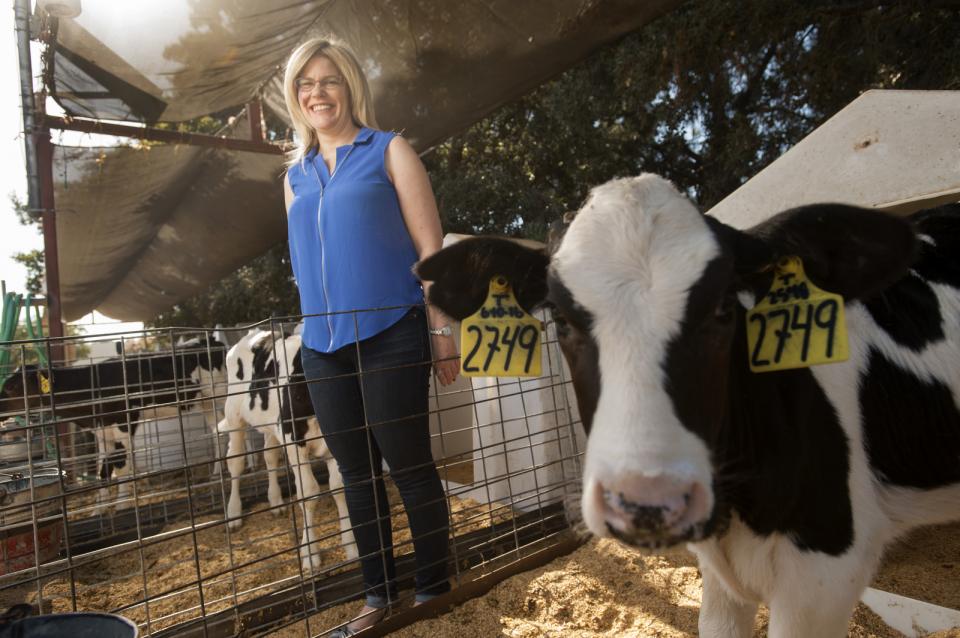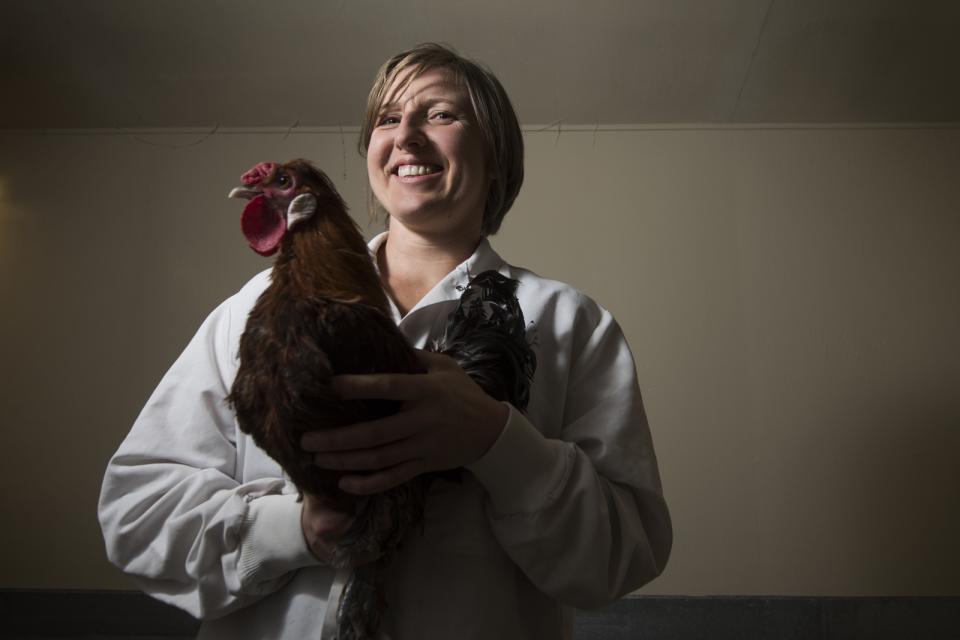创新背景
智能农场旨在应对农业领域的重大挑战,在气候变化的情况下,利用技术提高粮食和可再生能源的产量。50年或100年后,农场会变成什么样子?人口增长、气候变化和劳动力这些必须解决的问题引起了人们对技术的浓厚兴趣。
创新过程
2047年的早上:在加州中央谷的这个农场,白天休息的时候,工作正在进行中。一辆机器人拖拉机沿着一排排的番茄植株行驶,随着杂草的清除,它会咔嚓咔嚓地修剪。一架无人机在田野上空盘旋,寻找疾病的迹象。在饲养场,传感器显示哪些牛生长旺盛,哪些吃得少——这是疾病的早期迹象。
在她的办公室里,农场经理检查关于农作物和牲畜的数据,正在做什么以及需要注意什么。在整个农场,熟练工人既照料植物和动物,也照料机器。
由于技术的进步,这个未来的农场比以往任何时候生产更多的食物,以土地、劳动力、能源或材料的投入来衡量,而且使用的水更少,对环境和气候的影响也更小。它还为新一代农场工人提供技术职业。
这就是加州大学戴维斯分校智能农场计划(Smart Farm Initiative)背后的愿景。
斯劳特希望,通过汇集不同研究人员,智能农场将加快农业技术的发展,如机器人、植物科学和动物护理。与此同时,斯劳特和他的同事们希望培养新一代的高科技农场工人,同时让目前的劳动力转向不那么依赖繁重体力劳动的工作。

其中一些机器人已经出现在加州大学戴维斯分校的田野里。例如,在美国农业部的支持下,斯劳特的团队已经建造了一台自动化耕作机,以取代手工除草。这台机器被一辆拖拉机拖在后面,它能识别一排农作物中的杂草,并把它们从土壤中清除出来。
这种耕种机可以区分作物和杂草,因为作物的种子被涂上了荧光染料,当幼苗发芽和生长时,荧光染料会转移到幼苗身上。染料会逐渐消耗,但幼苗身上的染料量足以让耕种者把它们挑出来,并剪掉不发光的杂草。
另一个在加州大学戴维斯分校进行实地试验的机器人是一个安装在轨道上的盒子,它的伸缩颈上装有摄像头。机器人飞快地穿过一排高粱,给这些植物拍照并收集数据,以及它们能捕捉到多少光。这些数据会返回给植物育种家,他们可以用这些数据为下一轮的育种杂交做出新的选择。
植物对于机器人管理有一些明显的优势:它们不会移动,也不会踢翻机器人或试图吃掉它。但在饲养牲畜方面,新技术仍有很大的发展空间。
在生产动物中,健康状况不佳的第一个迹象是动物的食欲下降。如果能在单个动物身上使用传感器来监测它们的食物摄入和反刍行为,就能在看到其他临床症状之前就知道动物是否生病了。

在加州,肉牛一开始吃草,然后在饲养场养肥。饲养场系统使牛更快地进入市场,产生更少的温室气体排放,并更有效地利用土地。但当动物来到饲养场时,它们也会因为饮食的改变而出现健康问题。塔克表示,掌握更多关于单个动物的信息可以让牧场主围绕动物福利优化他们的系统。

家禽专家Maja Makagon正在使用新技术作为了解鸟类行为的工具,这可能会带来更好的动物福利和生产力。例如,Makagon在每只母鸡身上使用传感器来记录它们的龙骨(胸骨)与什么东西碰撞的情况。骨损伤是一个严重的问题,可以影响鸡蛋的生产。
创新价值
智能农场旨在应对农业领域的重大挑战,在气候变化的情况下,利用技术提高粮食和可再生能源的产量。
创新关键点
将先进技术应用于农场,未来的农场将比以往任何时候生产更多的食物,以土地、劳动力、能源或材料的投入来衡量,而且使用的水更少,对环境和气候的影响也更小。它还为新一代农场工人提供技术职业。
Creating the Farm and Farmworkers of the Future
Morning in 2047: Work is underway at this farm in California's Central Valley during a break in the day. A robotic tractor travels along rows of tomato plants, snapping back as weeds are removed. A drone hovered over the fields, looking for signs of disease. In feedlots, sensors show which cattle are thriving and which are eating less -- an early sign of disease.
In her office, the farm manager checks data on crops and livestock, what is being done and what needs attention. Throughout the farm, skilled workers care for machines as well as plants and animals.
Thanks to advances in technology, this farm of the future produces more food than ever before, measured in terms of inputs of land, labor, energy or materials, and uses less water and has less impact on the environment and climate. It also provides skilled careers for a new generation of farm workers.
That's the vision behind the Smart Farm Initiative at the University of California, Davis.
Slaughter hopes that by bringing together different researchers, smart farms will accelerate the development of agricultural technologies, such as robotics, plant science and animal care. At the same time, Slaughter and his colleagues hope to train a new generation of high-tech farm workers while shifting the current workforce toward jobs that are less reliant on hard manual labor.
Some of these robots are already in the fields at the University of California, Davis. Slaughter's team, with support from the U.S. Department of Agriculture, has built an automated tillage machine to replace manual weeding, for example. The machine, which is towed behind a tractor, identifies weeds in a row of crops and removes them from the soil.
The cultivator can distinguish crops from weeds because the seeds of the crops are coated with a fluorescent dye that is transferred to the seedlings as they germinate and grow. The dye wears off gradually, but the amount on the seedlings is enough for the cultivator to pick them out and cut the non-glowing weeds.
Another robot in field trials at UC Davis is a track-mounted box with a camera attached to its telescoping neck. The robot zips through a row of sorghum, taking pictures of the plants and collecting data, as well as how much light they can capture. This data is then returned to plant breeders, who can use it to make new choices for the next round of breeding crosses.
Plants have some obvious advantages for robot management: they don't move, and they don't kick over a robot or try to eat it. But there's still plenty of room for new technologies when it comes to raising livestock.
In productive animals, the first sign of poor health is a decrease in the animal's appetite. If sensors could be used in individual animals to monitor their food intake and rumination behaviour, it would be possible to know if an animal is sick before other clinical signs are seen.
In California, beef cattle are first grazed and then fattened in feedlots. Feedlot systems get cattle to market faster, produce fewer greenhouse gas emissions, and use land more efficiently. But when the animals come to the feedlot, they can also develop health problems because of changes in their diet. Tucker says having more information about individual animals allows ranchers to optimize their systems around animal welfare.
Poultry expert Maja Makagon is using new technology as a tool to understand bird behavior, which could lead to better animal welfare and productivity. Makagon, for example, uses sensors in each hen to record when their keel (sternum) hits something. Bone damage is a serious problem and can affect egg production.
智能推荐
AI+动物检疫学 | 利用机器学习全新揭示禽流感爆发的良好预测指标
2022-11-24创新使用机器学习研究影响家禽养殖场的禽流感爆发的因素,创建模型证明野生鸟类分布是家禽养殖场禽流感暴发的良好预测指标。
涉及学科涉及领域研究方向利用人工智能识别野外灵长类动物的行为
2022-08-09牛津大学的科学家开发了新的人工智能(AI)模型来识别野外黑猩猩的行为,这种方法将使研究人员和野生动物保护主义者能够大大减少在视频片段中分析动物行为所花费的时间和资源。
涉及学科涉及领域研究方向智慧科技+湿地保护
2022-06-29从已有智慧农业经验出发,开发智慧湿地保护体系,促进湿地保护恢复智慧高效管理服务,并和经济协同发展。
涉及学科涉及领域研究方向AI+农业 | 利用气候智能型农业实现更多灌溉
2022-08-24由加州大学戴维斯分校(UC Davis)领导的一个国际团队正致力于将危地马拉的9000个农村家庭与改善的水管理和气候智能型农业战略联系起来,以提高粮食安全并减少贫困。
涉及学科涉及领域研究方向